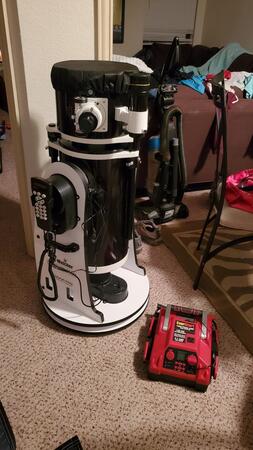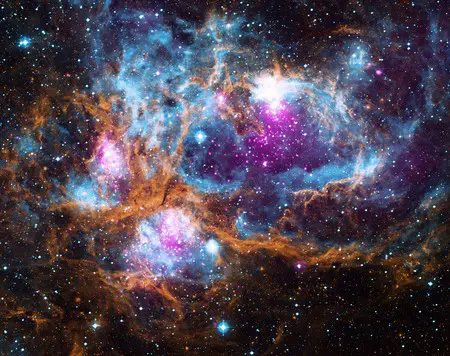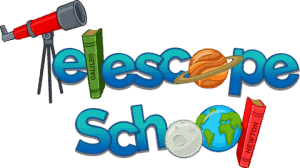The telescope named “Dobsonian” or “Dob” for short is a popular choice among amateur and experienced astronomers. Often nicknamed a light bucket, it offers a big aperture for a lesser price due to the design of its base. Let’s dig in and get to know more about the scope and the benefits you can enjoy from this style.
A Dobsonian is a Newtonian style telescope with some distinct features, that includes its unique alt-azimuth style base, and mirrors. One large mirror and a smaller right angle secondary mirror. A Dobsonian telescope uses the optic system of a Newtonian telescope and not the other way around.
What makes it a Dob? It is its alt-az mount, which makes it a Dob telescope. The weight of the larger mirror allowed for the balance point to be near the bottom. Creating a bottom base that allowed to spin and the scope tube to rock, or pivot made for a simple easy, and inexpensive mount, or base.
Will this type of telescope always use the Newtonian optic system? Yes, it uses that kind of optic system. This is the main reason why it is difficult to differentiate the two because they are highly comparable in almost all features except for the mount.
Who Invented a Dobsonian Telescope
The inventor of the Dob telescope is John Dobson where he got interested in Astronomy in the 1950s. He patented his ideal in 1965. He decided to express his genius ideas to Sky and Telescope in 1969, but they were not so much convinced with him. After a few years, his invention was eventually adopted by the society in 1980.
Unfortunately, John Dobson passed away last January 15, 2014. The entire Astronomical society was saddened by this significant loss. Nevertheless, his invention contributed greatly to the advancement of Astronomy and allowed for more space to be seen by people for less money.
What Advantages do Dobsonians Have Over Other Telescopes
There are plenty of benefits to enjoy from having this telescope for your astronomical adventures. It is a popular choice among amateurs and professional astronomers because of its simple design but excellent functionality and durability.
Let’s further uncover some advantages of using a Dobsonian telescope compared to other types of telescopes.
- Simple and Sturdy Mount – Dobs are mounted on a solid alt-az mount that is easy to manipulate. Likewise, when it comes to a stable mount, this telescope is unbeatable.
- Best Value for Money for Larger Apertures – Unlike refractors, getting a larger mirror is exceedingly affordable over getting a large lens. Further, compared to Cassegrain counterparts, a Dob provides an affordable option for large apertures. Even mounted Newtonian mirror-based scopes can get expensive due to the mount to make it sturdy.
- Newtonian Optical System – It has a flat and a curved mirror in its optic system, which captures the light from celestial objects. Because of a Dob mount, you can have a huge mirror and still have an inexpensive base/ mount
- Excellent for Deep Space Observation – Because of its optical system size, it has better abilities to capture fainter light from deep space objects. Likewise, a Dob provides a better experience when it comes to planetary viewing and the Moon due to its F/ratio or fast speed. Read more about f/ratio here.
- Best for All-Around Astronomical Experience – Basically, it is because you can use a Dob to view all astronomical things. Its fast speed or F/ ratio, along with the aperture size, make a combination of the ability to use it for anything. You can even get GoTo Dobsonians, or add on an equatorial base to get an hour or so of tracking for astrophotography
What Makes the Dobsonian Different Than Others
Aside from being the excellent choice for value of money, let us highlight some of the best and unique features, which makes it a Dob telescope.
- Thicker Mirrors – Typical mirrors used are thicker, like 10mm for every 60mm in diameter. Dobson used thinner glass because the tube design allowed for support of the thinner glass. His mirrors were typically 10mm thick per 160mm in diameter.
- Alt-az Mount – This is the trademark of a Dob telescope. It is simple to operate and durable construction. However, if astrophotography is your passion, I recommend a dobsonian equatorial base for that gig. Typically called a wedge to create the proper arc when moving azimuth
- Tubes – Dob tubes started out as fiberglass and aluminum. However today, they are made from paper to make it lighter and more comfortable to manipulate. Technically, there are two types of tubes, solid and an open truss tube.
- Solid tube – These types are easier to set up, and it tends to get heavier when the aperture exceeds 10”.
- Truss tube – This type of open tube design has its upper part called the upper cage can be easily removed or shorted for hauling to dark skies.
- Base – Most bases of this telescope have Teflon or comparable materials integrated into its structure as bearing surfaces for the pivot, or the “alt” and the spinning, or “azimuth” movements.
- Size – The starting size of the Dob telescope is 6” and can go up to 30”. However, the typical size that sells, and or you would see in the market is between 8” to 16”.
Here is a quick link to Amazon on the “Dobs” I like a lot for their price and craftsmanship. Keep an eye out because they are often available for 2-day Prime shipping as well. Zhumell Dobs.
For my GoTo Dobs, here is a link to Amazon for my favorite. Available 8” to 16” if in stock. Check them out here,
For a more detailed explanation, check out my Recommended Gear page on specs and features that set individual telescopes apart.
What Objects are Best Viewed with a Dobsonian
Dobsonian telescopes are ideal for viewing planets, the Moon, deep space objects like galaxies and nebula. This is possible because of the Newtonian optic system of this telescope. It has a large aperture to receive a substantial amount of light from fainter objects.
Planetary viewing through a Dobsonian, you may want a Barlow lens. Click here to learn more about Barlow’s, or click here to see my best 2″ and 1.25″ picks of Barlow’s
For a better image of your astronomical observation, it is best to find a spot where light pollution is the lowest. Especially with an open truss-style tube. You can do some searching for a few minutes to look for a good spot near your vicinity. Here is our article on how to know how dark your sky is above your head.
In terms of portability, there may be a problem. Check the weight and know the vehicle you are using will have room to haul your dob. The weight once separated isn’t too bad since they are made with lighter and durable alternative materials today.
I typically recommend a Dob for the country or rural areas where light pollution is at a minimum.
Need More?
Dobsonian telescopes are one of the top choices by beginners and professional astronomers because of the numerous benefits you can enjoy from it. The main advantage of getting a Dob is excellent deep space viewing and value for money.
Nevertheless, the final decision of choosing which telescope best fits your requirements depends on you. Take a step back and do some market research to clear out your thoughts further. You can also check out this article on how to buy a telescope.
If you like, we have other articles that you can check out for more information. You can also send us some questions or comments about Dobs, telescopes, and Astronomy.




